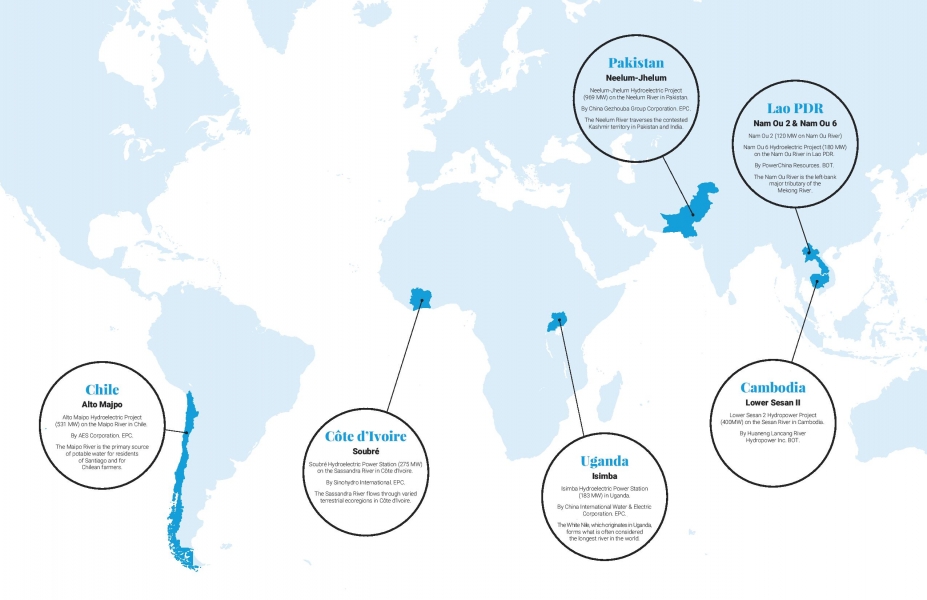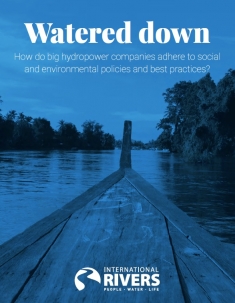Despite the enormous diversity in
size, scale and geography of new dams being built, a relatively small number of
corporations are responsible for their construction. Thus the policies and
practices of these companies have tremendous implications for rivers and human
rights. This report provides context for this situation and features seven
in-depth case studies of dams at final stages of completion. The case studies
are evidence-based and descriptive of on the ground impacts; they cover a wide
geography, and are considered to be flagship projects of some of the most
influential companies in the hydropower sector. The intention of this report is
to provide an incentive and justification for these corporations to compete on
their environmental and social track records rather than simply on financial
grounds.
The seven projects reviewed include:
- Soubré Hydroelectric Power Station (275 MW) on the Sassandra River in Côte d’Ivoire. By Sinohydro International. EPC.
- Isimba Hydroelectric Power Station (183 MW) in Uganda. By China International Water & Electric Corporation. EPC.
- Alto Maipo Hydroelectric Project (531 MW) on the Maipo River in Chile. By AES Corporation. EPC.
- Neelum-Jhelum Hydroelectric Project (969 MW) on the Neelum River in Pakistan. By China Gezhouba Group Corporation. EPC.
- Nam Ou 6 Hydroelectric Project (180 MW) on the Nam Ou River in Lao PDR. By PowerChina Resources. BOT.
- Nam Ou 2 Hydropower Project (120MW) on the Nam Ou River in Lao PDR. By PowerChina Resources. BOT.
- Lower Sesan 2 Hydropower Project (400MW) on the Sesan River in Cambodia. By Huaneng Lancang River Hydropower Inc. BOT.

Download the report:
- Watered Down: Full Report
- Watered Down: Executive Summary (English) (Chinese) (French)
Major Chinese state-owned developers are failing to meet basic environmental and social standards as they build massive dam projects around the world, US-based non-profit International Rivers has warned.
In a new report “Watered Down”, the organisation said many of the Chinese companies fell short of accepted international social and ecological standards, such as those set by the World Bank’s International Finance Corporation.
The researchers also found that the firms “routinely
compromise social and environmental objectives and disregard their stated
policies to keep to schedule and on budget”.
“If companies want to be considered standard-bearers in the sector, they must
require that certain conditions are met before entering into a project,” said
Josh Klemm, International Rivers policy director and co-author of the report.
“Basic steps like requiring disclosure of impact assessments, or foregoing projects that would impact Unesco sites, should be non-negotiable.”
The report was based on interviews and site visits to seven power dam projects in Uganda, Ivory Coast, Pakistan, Laos, Chile and Cambodia between 2016 and 2019.
All but one of the projects – the AES-built Alto Maipo project in Chile – were constructed by Chinese firms, who together account for two-thirds of the big dams built around the world.
Four of the seven projects reviewed failed to publicly disclose their environmental impact assessments (EIAs), and many of the projects did not consider or include concerns from local stakeholders, the report said.
“Only one of the seven projects studied made full environmental impact assessments publicly available before construction,” it said.
According to International Rivers, the companies “laid responsibility on host governments”, saying such issues were beyond their mandate.
In Uganda, China International and Water and Electric – a subsidiary of China Three Gorges Corporation – went ahead with construction of the Isimba Hydroelectric Power Station on the White Nile, despite warnings that the project would submerge important protected natural areas, the report said.
The US$568 million dam, which was 85 per cent financed by Exim Bank of China, directly affected the Kalagala offset area, home of the Kalagala Falls, a protected site of cultural, spiritual and biodiversity value for local communities.
“Isimba’s reservoir has submerged several important whitewater rapids, negatively affecting the rafting industry which drives the local economy in an underserved part of the country,” the report said. There was no impact assessment done despite several existing and planned dams on this stretch of river, the researchers said.
During site visits and interviews, China International and Water and Electric said the cumulative impact assessment was the responsibility of the developer, the Ugandan government, which had not conducted such an assessment, the study said.
In Pakistan, the EIA for the Neelum-Jhelum Hydroelectric Project on the Neelum River in contested Kashmir was conducted during the construction process and released three years after the construction had started, the report said.
China Gezhouba Group Corporation, the project’s builder, said that, according to the contract, the EIAs and resettlement plans were the responsibility of the proprietor, Pakistan’s Water and Power Development Authority.
On environmental degradation, a senior manager at the company explained to International Rivers that the Neelum-Jhelum Hydroelectric Project would not cause sediment issues because the project adapted a bottom-hole over-current structure, instead of the conventional surface-overflow dams that block the river.
It said the sediment pond included a specific function to wash the sand so that all sand washed away from the pond would flow back to the Neelum River.
And in Ivory Coast, Sinohydro International ignored environmental concerns and failed to establish a complaints mechanism for communities affected by construction of the Soubré Hydroelectric Power Station, according to the report. The project, on the Sassandra River, cost US$572 million and was also majority financed by Exim Bank of China.
The report said companies routinely overlooked what should have been major red flags.
Chinese firm Huaneng Lancang River Hydropower pushed forward with the Lower Sesan 2 hydropower project in Cambodia despite widespread protests and opposition from communities.
And in Chile, America firm AES pressed on with construction of the Alto Maipo project in the face of widespread public protest over the project’s impacts on the primary drinking water supply to the capital, Santiago.
Other projects featured in the study were two power dams in Laos by Powerchina Resources.
Source: South China Morning Post


